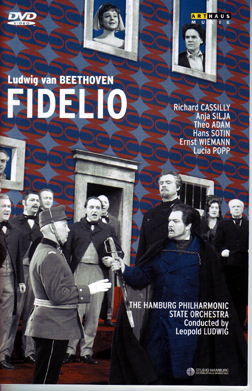
(845) 246-6944
· info@ArtTimesJournal.com
By FRANK BEHRENS
ART TIMES June 2007
 |
Of
the now countless video offerings
of operas, most are “live” performances while an increasing number are
made in a studio, usually with lip-synching. As each has an advantage
over the other, I would like to give a few examples.
A
video of a performance given before an audience means pretty much that
you see what the audience saw, except for the close-ups and occasional
camera effects that the audience could not have seen. You see the orchestra
before each act, you hear the applause to greet them and to reward the
singers after an aria or ensemble, and (in short) you share the experience
with the audience.
Or
do you? You are at home watching this video. You have no contact with
that audience. In fact, they are part of the show, as it were, in dress
and demeanor acting to no less a degree than the singers on stage. In
a way, you are more aware of the production as a social event. Might
one suggest a ritual?
Now,
when watching a film you MIGHT think of the cameramen, the script person,
the director, and all the crew that are not seen on the screen. You
simply let yourself believe that Laurence Olivier IS Hamlet or Richard
III, and you believe that all of this is “really” happening.
Here
is a good case in point. In the late 1960s and early 1970s, 13 operas
were filmed to be shown on German television. This was because of Rolf
Liebermann, who built the Hamburg State Opera into a formidable organization.
After a tour of North America, the film and TV company Polyphon decided
to telecast versions of those operas based on productions already performed
on stage in Hamburg. Joachim Hess was chosen to do the film adaptations.
The
telecasts were a great success and have languished in vaults until quite
recently when ArtHaus Musik was given the rights to make some of the
films available on DVDs. The earlier films show some unfamiliarity with
the art of lip-synching. That skill was quickly mastered and the later
films seem to be done “live.”
The
later releases so far include Lortzing’s “Zar und Zimmerman,” Beethoven’s
“Fidelio,” Von Weber’s “Der Freischutz,” Berg’s “Wozzeck,” Penderecki’s
“Die Teufel von Loudun,” and Wagner’s “Die Meistersinger.” More might
have been added by the time this essay is printed.
Now
for some comparisons.
I
will take two videos of “Meistersinger” as an example. There is the
spectacular version performed at the Metropolitan Opera in 2001. Here
we have realistic sets, costumes appropriate to the time and place of
the action, and a good cast. Ignoring the fact that the young Eva looked
far too matronly in close-ups, it was an impressive production that
left me somewhat uninvolved with the characters. I have never found
this work particularly exciting once the overture is over and I look
forward to the riot scene that ends Act II and the procession of the
guilds in Act III.
Not
too long after viewing that Deutsche Grammophon video, I saw the ArtHaus
DVD. Here was a color studio-made version from 1970. Although the tenor
was not exactly attractive and something of a wooden actor, I found
myself very IN-volved indeed. Perhaps the acting was a bit more natural,
perhaps the proximity of the camera let the cast ease up on projecting
emotion to the top balconies. I don’t know. I simply feel I would like
to see this version again in its entirety and the Met version only in
parts.
The
1968 “Fidelio” from Hamburg is sensibly costumed in the correct period
and is far more effective than the updated
costumes and settings offered in the Metropolitan Opera performance
released on video in 2002; and again I find myself more in sympathy
with the characters and their problems.
On
the other hand, the film version of “Der Teufel von Loudon” contains
far too much nudity and sadism to show on a stage. The latter is so
realistically graphic that I had to stop watching it towards the end.
There
is, of course, one major disadvantage to studio-made operas. Liebermann
himself is quoted in the program notes to “Fidelio” pointing out that
he realized after filming 6 of the 13 operas that “miming falsifies
a singer’s facial expressions. A high B or C doesn’t ring true if the
singer has a completely relaxed expression.” Indeed, in some operatic
films non-singing actors are used to mouth the voices of less attractive
opera singers. (Do you remember Sophia Loren as Aida?)
Another
problem with films shows up in the “Wozzeck” video. The action is certainly
earthy and the sets are “on location,” both of which features make it
awkward to have the characters singing rather than speaking.
In
sum, I have to conclude that there is a place for both “live” and studio-made
videos—as long as they are intelligently directed by people who
respect the work and do not want to build a reputation merely by outrageous
settings and costumes.